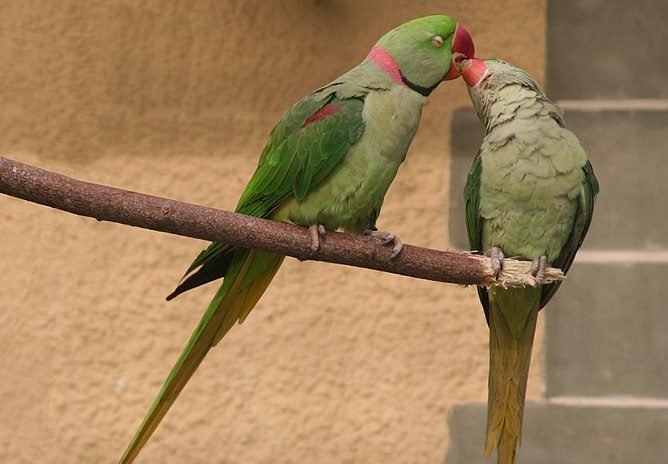Alexandrine parakeets are one of the most commonly sought parrots globally. Due to their affectionate nature, Alexandrine Parakeets can grow a very strong bond with humans. They eat a large variety of foods and can adapt to their surroundings easily.
All of these traits make this parrot a great beginner pet.
If you’re in the process of getting a parrot and want to learn more about the nature of Alexandrine parakeets, then keep on reading this article where we make an overview and cover all the basics regarding keeping Alexandrine parrots as pets.
Table Of Content:
- Alexandrine Parrot in Wild
- Alexandrine Parrot in Captivity
- Alexandrine parrot size, color, and markings
- Are Alexandrine Parrot Loud?
- Alexandrine Diet and Nutrition
- Alexandrine Bredding
- Common Health problems
- Alexandrine VS other pets
Alexandrine Parakeet origin
To understand more about this loving creature, we should touch on where they come from. Alexandrine parrots natively live in the dense forest lands of Sri Lanka and India. They got named after Alexander the Great, who was a passionate bird keeper and transported Alexandrine parakeets to Europe and some Mediterranean countries.
Ever since then, these birds have adapted to living in different climates and different flora, but feral populations still mostly inhabit forestland of warmer areas in Europe and Asia.
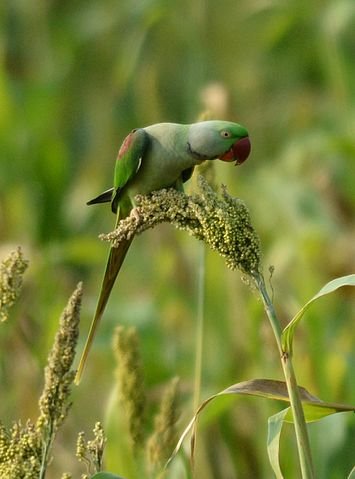
Because they have managed to adapt to living in different areas around the world, these little parrots have a very diverse diet. They are omnivorous by nature, so they feast on basically anything they can find on the ground, including insects, larvae, fruit, flowers, seeds, nectar, but also corn, which is why many rural areas hosting wild Alexandrine Parakeets even deem them as a pest.
For pet owners, this information is encouraging, as you have a large variety of food options to choose from when thinking of what to feed your Alexandrine parakeet – no matter where in the world you’re located. You can follow our guide to the diet of an Alexandrine parakeet to learn more regarding this segment.
Alexandrine Parakeets in the wild
In the wild, alexandrine parrots usually live in the form of small flocks. They are omnivores in nature and typically feed on various foods in the wild. The variety of food includes seeds, blossoms, and fruits.
These parrots known as sentinel birds because they make loud calls, especially when they are in danger, but are more comfortable on the trees. These parrots are difficult to find when perched on the trees. But the calls from these birds can be heard.
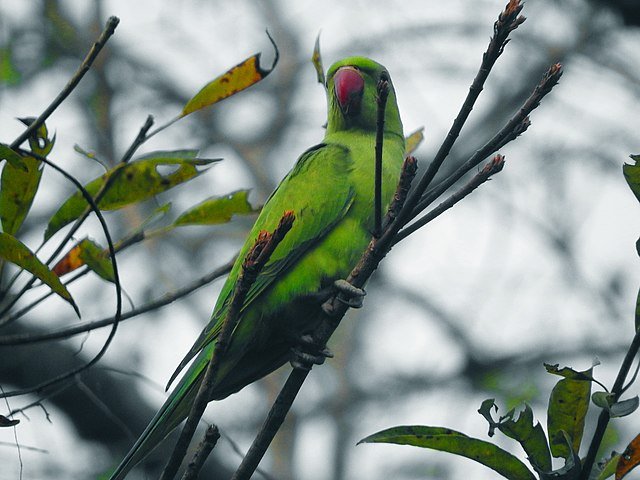
In the wild, these birds will branch off in pairs, during the breeding season, to raise the off-springs. The female parrot will look out for a nest cavity within a large tree to incubate the eggs, while male parrot will look after for the feed and danger.
Alexandrine Parrot in Captivity
These parrots are less compare common in captivity as compared to the other birds like the Indian Ring-necks, or the other Asiatic cousins. These birds can breed easily and are wonderful pet birds. These parrots are famous due to their mimicry expertise but still, the destruction of the habitat has diminished the presence of these birds in the wild.
Alexandrine parrot size, color, and markings
Alexandrine parakeets can grow very large in comparison to other parakeet parrots, measuring up to 62cm in length, while their tail can grow up to 35cm.
They are predominantly green, but they tend to have a bluish and/or greyish sheen on their back, nape, and tail. The underside of the tip of their tail and belly is enriched with mustardy-yellow feathers, while their shoulders and beak feature a bold, brick-red color.

Alexandrine parakeets fall into the category of dimorphic bird species, meaning that males and females feature slight visual differences; Adult males have a pink ring-like band on their nape, as well as a black stripe across their lower cheeks. Females lack both.
They are very similar to Indian Rednecks, however, Indian Rednecks are generally smaller and lack the sheen, as well as the yellow belly.
Are Alexandrine Parrot Loud?
Generally speaking – Alexandrine Parrots does not make a lot of noise. If they don’t have a companion bird at home, they might release a so-called “flock call” in the evening or morning. Like other parrot species, they might chirp moderately when they’re curious, excited or happy, without any excessive screaming and yelling.
Speaking of curiosity – these birds are VERY curious. Alexandrine parrots will want to know all about their surroundings, including other humans and animals living there. They can pick up sounds, melodies, and words in no time. Don’t be surprised if they start using sounds your other parrots make, or if they start repeating words you say without any rhyme or reason. This is their way of bonding and interacting.
However, before they get to know you – they will enforce their natural behavior, including presenting you with a variety of their calls, amongst which are the infamous “gr-aak” call, deep clacking noises and ringing sounds.
They have very loud alarm calls. They can exhibit these when they are surprised or scared, but if they keep repeating them without a definitive pattern this could be due to the fact that they are bored and unsatisfied.
Alexandrine Diet And Nutrition
Alexandrine parrots or alexandrine parakeets are larger parrots; therefore, their diet should be higher in fresh foods and minimum in nuts and seeds. Alexandrine parakeets love to have a diet containing leady greens, tree nuts, fresh vegetables, grains, some premium-quality commercially available pelleted diet and healthy seeds.
Fresh vegetables are the basic and essential diet ingredients for the birds.
It is essential to mix the diet by offering a half cup of vegetables and fruits, and a half cup of pellets. However, the adjustment of the feed must be according to the appetite of the birds. Removing uneaten foods will help to prevent the spoilage of the food and keep the alexandrine parakeets healthier.
Nuts like almond, hazelnuts, walnuts, peanuts are among the favorite nuts of the parrots. However, these nuts should be minimum in the diet as they consist of a large amount of fat. Spoon feeding to the adult alexandrine parrot will help to minimize the stress if any medication required during the disease condition.
It is not advisable to provide some foods like chocolate, avocado, sugary candies, and alcohol to the parrots as these foods have harmful effects on the health of the alexandrine parrots.
Some foods are toxic to the parrots and must keep away from them. These foods include avocado, cabbage, apple, lettuce, pear seed, chocolate, and ray beans. An alexandrine parakeet can enjoy a lifespan of 20-30 years by providing a proper diet along with health care.
Alexandrine parakeets exercise
Alexandrine parakeets are among the active birds as they require excessive exercise to sustain their emotional and physical health. Therefore, to provide the necessary daily exercise, a cage with sufficient space is ideal for these lovable birds. A pen is preferable in which there are secure by expanding their wings without doing any damage to their beautiful and long tail feathers.
Alexandrine parakeets require 3-4 hours per day to fulfill the requirement of daily exercise. Adequate supervision is necessary for these birds as they can get stuck into the trouble very quickly if remained unsupervised. However, these birds can get bored quickly; therefore, there should be excessive chewable toys to make these birds interested in the play.
Breeding Alexandrine Parrots
The breeding seasons of alexandrine parakeets vary according to the location. Due to the aggressive protecting behavior of these birds, colony breeding is not possible for these birds. A fight during the breeding season can lead to severe injuries that may result in the death of the birds. There should be only one pair per cage and it is preferable to have bred in roomy aviaries.
The nesting boxes for theses ring-necks birds should be a bit deeper or must be in boot-shaped to provide security to the female parrots. Reinforcement of metal plates outside the wooden boxes will help to make sure that the female parrot will not chew the bottom of the boxes. Some breeders will prefer to use metal boxes as they are more reliable, easy to clean and are more durable.
There should be wood shaving at the bottom of each nesting box before placing it in the breeding cages. The female parrots will try to remove most of the shaving when she initiates to work for the nest. There should make a few handful backs in the box to make sure that the eggs will have padding when laid.
The female parrots will lay eggs between two to four and will incubate the eggs for 26 days. The chicks will make a hole in the egg to breathe before they hatch out from the egg. The process of hatching usually occurs within 1-2 days of the formation of the hole.
The babies’ alexandrine parrots will leave the nest within 7-8 weeks of age and will wean around ten weeks if kept along with the mother parrot. The breeders can have two clutches per annum if the breeders remove the eggs and keep in the incubator during the early breeding season.
Read more about Alexandrine parrot Breeding
https://parrotquaker.com/alexandrine-parrot-breeding/
Common Health Issues
- Aspergillus
This is a fungal disease of parrots that affect the lungs and the air sacs of the alexandrine parrots and usually happen due to the dirty environment. This disease usually causes breathing problems along with fluffed feathers and wheezing sounds in the parrots.
Candidiasis
This is a yeast infection, and it usually affects the crop or the digestive system of the bird. However, there some chances of transmission from parrots to humans. The parrots will become listless and will have loss droppings.
Cold
The parrots are more prone to cold, and they will show signs like swollen eyes, sneezing, and running nose. However, this cold can cause fatal effects on the health of the birds, and vet assistance will become necessary.
Parrot Fever
This disease is the worst thing that can happen to the aviary. This illness spreads rapidly within the aviary and leads to the death of the birds within the aviary. It is a bacterial disease, and this bacterium can survive in the dropping and soil for a more extended period. The best prevention against this illness is to keep the cages clean and disinfect them regularly.
Alexandrine parrot Behaviour
Alexandrine parrots are very loving birds. When bonding with humans, they tend to show a lot of affection. Although they are very feisty, quirky, and have a very strong personality, they usually aren’t aggressive and don’t throw irrational fits.
Despite their generally calm nature, just like many other Asiatic parrots – Alexandrine parakeets tend to go through the “bluffing stage”. Bluffing is also commonly called the juvenile biting stage. Bluffing happens between the ages of four months to one year and can last from a couple of weeks to a couple of months.
If you notice that your parrot is becoming more irritable to noises and petting, bites more, demands more attention, and exhibits a more hysteric behavior out of nowhere, a visit to the vet is a good idea. However, if your parrot is young and the vet finds no physical cause, juvenile biting is the most likely answer.
Bluffing happens due to hormonal shifts when transcending from juvenile age into adulthood, so bluffing is essentially the equivalent to the rebellious teenage age in parrot language. After they grow up and become adult parrots, they will return to their old behavior.
They like to have patterns in their daily life, pick up interests, and hang out in different spots throughout the day. Allowing them to feed their curiosity by letting them out of their cage and enabling them to explore their surrounding space and objects will help them settle into their new forever home. Not keeping them restricted will also give them a sense of acceptance and security, so they will be more open to the idea of establishing a relationship with you.
Alexandrine temperament
Alexandrine parrots are affectionate pets. However, these parrots tend to be one-person birds. These parrots develop a strong linkage with their favorite member of the family and shun others within the household.
Alexandrine parakeets within the age of four months until one year have some hormonal aggressiveness that is difficult to handle for the owners.
This time can last from fifteen days to two years, depending on the bird.
These birds are intelligent and known as great talkers, which makes them popular pet birds. These birds settle in the new living environment by the usage of proper bonding techniques and socialization.
Connecting with humans
They highly respect interaction and stimulation. In a household with many members living together, they do tend to become so-called “one-person” birds. This is not to say that they won’t get along with or love the rest of the family members, but they will usually pick one particular person as their favorite and be more clingy, as well as allow them more petting and cuddling time. They like to be closer to you, so in an attempt to do so – they will closely monitor your behavior and mimic certain sounds and actions that you make and do. They will pick up words very quickly and will be very open to training as part of play-time.
Stimulation is a very important factor when it comes to keeping an Alexandrine parrot. Not only will they become noisier when dissatisfied, but they are also known for their tendency to pluck their own feathers when stressed or bored.
That being said, you don’t need to devote every second of your day for your parrot to be happy – just don’t ignore them. Keep them on your shoulder when you work, talk to them or pet them when you pass by, give them little signs that you are aware and glad that they’re there.
Relationship with other pets
Alexandrine parrots tend to get along well with just about any pet.
They like to play with cats, but be very well aware that your parakeet seeing your cat as a playmate does not mean that it’s the other way around. Introduce them slowly and carefully and make your cat realize that your parakeet is not a toy.
Make sure to trim your cat’s claws regularly, as parakeets have very sensitive skin. Cats are predators by nature, and their habits of playing are not suitable for parakeets. Even if your cat does not hurt your parakeet when you’re around, keep them in separate rooms should you have to leave them home alone.
Alexandrine parrot and Dogs
Dogs are not predators that naturally feast on birds the same way cats are, but they do also have a tendency to jump and bite. If your dog and parakeet establish a close-knit relationship, it’s very unlikely this will happen, as dogs – just like Alexandrine parakeets – have a devoted and loving nature that could make them grow fond of their new feathery friend.
This will require some preparation, especially if your dog wasn’t acquainted with other birds before. Be present, allow them to sniff and smell your parakeet in order to familiarize themselves with them. Supervise their interactions until you are absolutely sure that your dog is also at a stage where he recognizes the parakeet as a family member and becomes protective of your pet parrot.
When it comes to other birds and pet parrots, it’s a pretty hit-or-miss scenario. You see, Alexandrine parrots more often than not like to have a companion of their own kind. Giving them another playmate that is an Alexandrine parakeet will give them more fulfillment in their daily life, especially when you have a lot of work to do.
If you’re getting one of their “cousins” (a parakeet of another kind) then try and get a same-sex playmate in order to avoid cross-breeding.
When it comes to other parrot species, their attitude is very individual from a parakeet to a parakeet. Sometimes, they will look up to this parrot as their teacher and add them to the list of entities to mimic, sometimes they will have a neutral friendly bond, and sometimes the Alexandrine parakeet will become very jealous and territorial.
If you have a smaller second pet parrot such as a budgie, then don’t leave them alone if you notice hostility from your parakeet’s side – they have very large and strong beaks that might be dangerous to your smaller feathery companions. If you want to explore other parrots, it would be ideal to get one larger than the Alexandrine parakeet.
Alexandrine Parakeet VS Other Birds
Alexandrine parakeets are social and sweet parrots, and they do like the company of other parrots too. However, every type of birds doesn’t have compatibility with alexandrine parrots. Therefore, it is necessary to have some friends for the parakeets to like in a friendly environment.
Compatibility with other Alexandrine parakeets
Alexandrine parakeets are compatible with other parakeets. The female parakeets are dominant among alexandrine parakeets; therefore, keeping male parakeets together is far more suitable for them to live friendly. Placing two females parakeets together also works, but make sure the cage is large enough that permit to isolate them. If the pen is small for the females, then they will fight with each other.
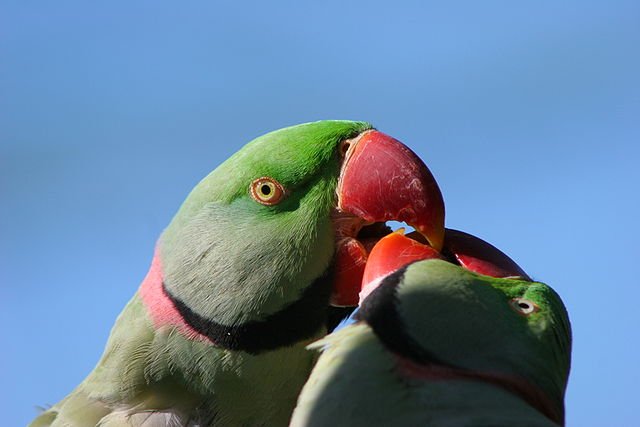
Alexandrine VS Cockatiels
Alexandrine parakeets usually go well with the cockatiels. Parakeets remain dominant in this companionship. Arranging additional bathtub and a few branches will help the birds to keep the confrontation at bay.
Birds to Avoid with Alexandrine
Alexandrine parakeets will not tolerate a canary. It is thus advisable to place them in isolated pens. Some birds like Bourke’s parrots and Rosella do well but only when placed in larger aviaries. Nevertheless, still, the danger is there to fight parakeets and rosella, as both are aggressive when kept together.
Alexandrine parrot Cage
As these parrots require space and interaction, it’s ideal to keep the cage as a sort of sleeping area. This means that you don’t actively keep your Alexandrine parakeet in their cage, but rather leave them there for bedtime or when you have people and animals in the room that your parakeet doesn’t get along with.
If it’s not possible to let your parakeet out for the majority of the day, you will at least need to give them three to four hours outside to allow them to explore and stretch.
To avoid a scenario where your parakeet has the impression that their cage is there only for confinement, you can keep their main feeding bowl and water dish inside the cage, which encourages positive feelings.
Cage Size and setting
The cage needs to be big enough so that your parakeet can stand and turn comfortably without its tail touching the sides. The minimal dimensions of the cage should be 32 inches in height, 20 inches in width, and 39 inches in length. The bars should be placed in the upper portion of the cage, as you don’t want their tale to dangle across the bottom.
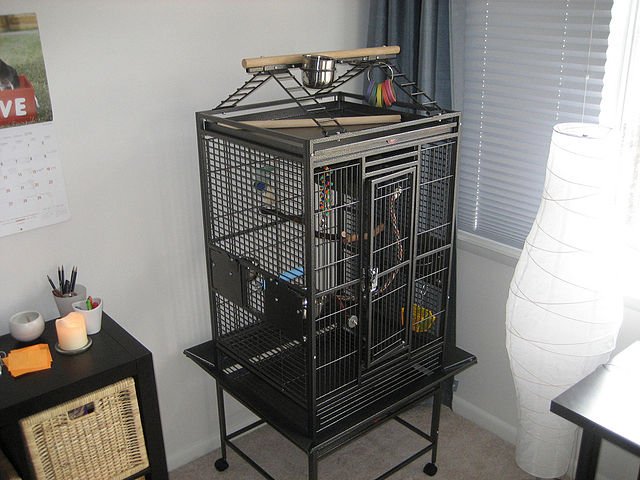
If your Alexandrine spends a lot of time inside their cage, then opt for a larger cage so that they can jump around. You can also set up a larger outdoor enclosure where your parakeet can catch a little sunshine.
Please remember to fill your cages with lots of interactive toys to make sure that your parrot isn’t bored when they’re inside, but don’t substitute their moving space. You can also place a mirror inside their cage if your parrot doesn’t share his or her cage with any other birds, as they tend to feel lonely.
Placement in Room
You should place their cage in the living room area where you and your family members spend most of your active time so that your parakeet gets a sense of belonging.
If you’re busy or absent, giving them a view outside the window might provide more stimulation.
Do not place the cage next to a TV or radio, as artificial sounds and images may bother them, especially at night time. They require a regular sleeping regime.
Do not put your cage right next to air conditioning or heaters. Keep the placement as neutral as possible to avoid harsh temperature changes.
Avoid putting your cage on refrigerators and other appliances that might vibrate or cause noise.
Playtime ideas
Alexandrine parakeets are by nature very active birds and require a lot of physical exercise for the benefit of their overall health.
Alexandrine parakeets don’t like to just aimlessly jump around – they love challenging their intelligence through puzzle games. You can hide a treat for them and let them find it, or put treats in mazes and under cups and boxes and let them figure out how to get to them.
Let your imagination run wild and include slides and hoops and make a small playground. They love to be trained (especially if treats are involved). They will appreciate your time and effort to teach them how to behave and what to do.
They love mobile and noisy toys such as balls, bells, and baby rattles, however, you should also provide them with softwood toys or cracker stick treats so that they have something to chew on and trim their beak with. You can combine this chewing obsession with their puzzle affinity and roll up a treat in a paper ball – allowing them to rip it apart in order to get to the treat.

Play peek-a-boo and sing and dance with your parrot, they will enjoy that they can vent their energy with you by their side doing the same with them.
Alexandrine parakeet lifespan
In the wild, the average lifespan of an Alexandrine parakeet is around two decades. Their longevity is severely compromised by weather changes, predators, shortage of food, potential draught, and pesticides on crops of local farmers. They usually live in pairs or flocks, so they’re not used to solitude. If an Alexandrine happens to get lost, their chance of survival becomes smaller.
In comparison, Alexandrine parakeets can live for more than 30 years in captivity, meaning that if you add a reasonable dose of care into the mix – this parrot could potentially grow old with you. As long as you provide them with a safe shelter, plenty of food and vegetables, and allow them daily exploring and exercise, they will outlive their feral brothers. They are used to different climates but don’t handle harsh changes too well, so keeping them indoors during winter gives them the privilege they wouldn’t have in the wilderness.
Training your parrot mentally is also essential for their well-being. Mental boredom can cause a lot of stress on Alexandrine parakeets, so allowing them constant stimulation either by providing them toys or playing with them is crucial for a long and healthy life.
To sum it all up
Alexandrine parakeets are great beginner pets. Their diet consists of a wide range of food items that you yourself almost always have at home. They are very easy to train, very open to learning new habits, and are very calm and loving. They pick up words easily and are generally welcoming towards other humans and animals, although you should be cautious of cats and smaller birds.
Alexandrine parakeets like to explore and don’t like being confined to their cage for long periods of time. They can also be very clingy in a very likable way, especially towards one specific person, so if you are open to the idea of having a small friend follow you around the house you will not go wrong with choosing the Alexandrine parakeet.
If you yourself are afraid of loss and grief and want to have a pet that will accompany you through life, then Alexandrine parakeets are a great option again, because when in captivity – they can live for 30 years or more. This, of course, requires proper care that does not just simply giving them good food and taking them for regular vet check-ups. They may be easy to take care of in technical terms, but they require a lot of stimulation, love, and attention in order to stay happy.
Having said that, Alexandrine parakeets also aren’t difficult to please – as long as you include them in your daily life and interact with them when they approach you, they will feel welcome, happy, and content. Your efforts will be paid back with many adorable and irresistible cuddle sessions.
Read about Blue Alexandrine mutation:
https://parrotquaker.com/all-about-blue-alexandrine-parakeet/

